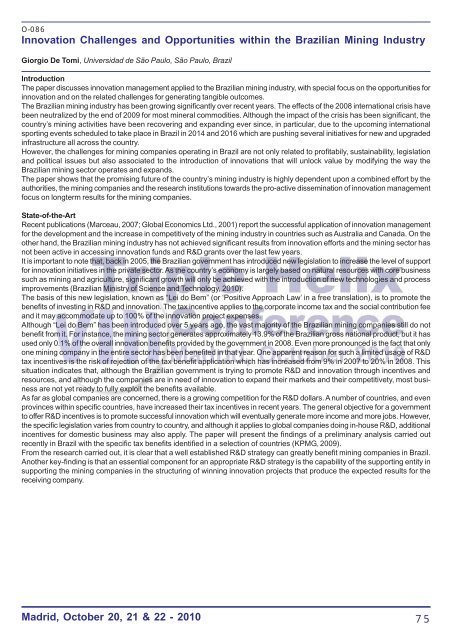TRIPLE HELIX noms.pmd
TRIPLE HELIX noms.pmd
TRIPLE HELIX noms.pmd
You also want an ePaper? Increase the reach of your titles
YUMPU automatically turns print PDFs into web optimized ePapers that Google loves.
O-086Innovation Challenges and Opportunities within the Brazilian Mining IndustryGiorgio De Tomi, Universidad de São Paulo, São Paulo, BrazilIntroductionThe paper discusses innovation management applied to the Brazilian mining industry, with special focus on the opportunities forinnovation and on the related challenges for generating tangible outcomes.The Brazilian mining industry has been growing significantly over recent years. The effects of the 2008 international crisis havebeen neutralized by the end of 2009 for most mineral commodities. Although the impact of the crisis has been significant, thecountry’s mining activities have been recovering and expanding ever since, in particular, due to the upcoming internationalsporting events scheduled to take place in Brazil in 2014 and 2016 which are pushing several initiatives for new and upgradedinfrastructure all across the country.However, the challenges for mining companies operating in Brazil are not only related to profitabily, sustainability, legislationand political issues but also associated to the introduction of innovations that will unlock value by modifying the way theBrazilian mining sector operates and expands.The paper shows that the promising future of the country’s mining industry is highly dependent upon a combined effort by theauthorities, the mining companies and the research institutions towards the pro-active dissemination of innovation managementfocus on longterm results for the mining companies.State-of-the-ArtRecent publications (Marceau, 2007; Global Economics Ltd., 2001) report the successful application of innovation managementfor the development and the increase in competitivety of the mining industry in countries such as Australia and Canada. On theother hand, the Brazilian mining industry has not achieved significant results from innovation efforts and the mining sector hasnot been active in accessing innovation funds and R&D grants over the last few years.It is important to note that, back in 2005, the Brazilian government has introduced new legislation to increase the level of supportfor innovation initiatives in the private sector. As the country’s economy is largely based on natural resources with core businesssuch as mining and agriculture, significant growth will only be achieved with the introduction of new technologies and processimprovements (Brazilian Ministry of Science and Technology, 2010).The basis of this new legislation, known as “Lei do Bem” (or ‘Positive Approach Law’ in a free translation), is to promote thebenefits of investing in R&D and innovation. The tax incentive applies to the corporate income tax and the social contribution feeand it may accommodate up to 100% of the innovation project expenses.Although “Lei do Bem” has been introduced over 5 years ago, the vast majority of the Brazilian mining companies still do notbenefit from it. For instance, the mining sector generates approximately 13.9% of the Brazilian gross national product, but it hasused only 0.1% of the overall innovation benefits provided by the government in 2008. Even more pronounced is the fact that onlyone mining company in the entire sector has been benefited in that year. One apparent reason for such a limited usage of R&Dtax incentives is the risk of rejection of the tax benefit application which has increased from 9% in 2007 to 20% in 2008. Thissituation indicates that, although the Brazilian government is trying to promote R&D and innovation through incentives andresources, and although the companies are in need of innovation to expand their markets and their competitivety, most businessare not yet ready to fully exploit the benefits available.As far as global companies are concerned, there is a growing competition for the R&D dollars. A number of countries, and evenprovinces within specific countries, have increased their tax incentives in recent years. The general objective for a governmentto offer R&D incentives is to promote successful innovation which will eventually generate more income and more jobs. However,the specific legislation varies from country to country, and although it applies to global companies doing in-house R&D, additionalincentives for domestic business may also apply. The paper will present the findings of a preliminary analysis carried outrecently in Brazil with the specific tax benefits identified in a selection of countries (KPMG, 2009).From the research carried out, it is clear that a well established R&D strategy can greatly benefit mining companies in Brazil.Another key-finding is that an essential component for an appropriate R&D strategy is the capability of the supporting entity insupporting the mining companies in the structuring of winning innovation projects that produce the expected results for thereceiving company.Madrid, October 20, 21 & 22 - 201075










